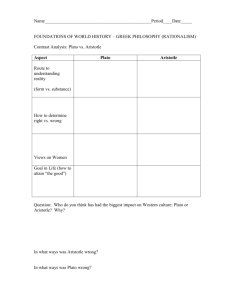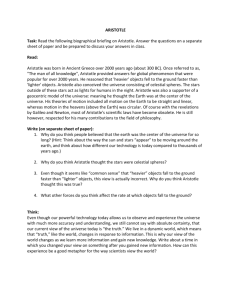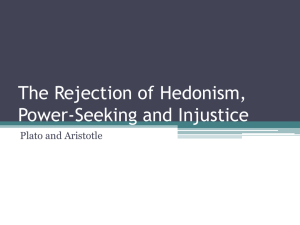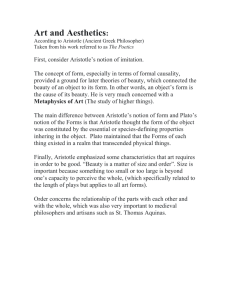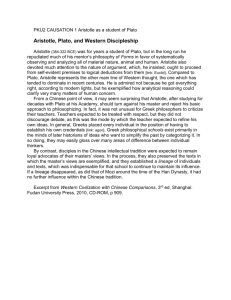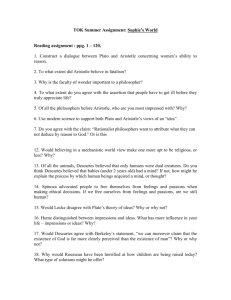Lec 3 & 4 Aristotle
advertisement
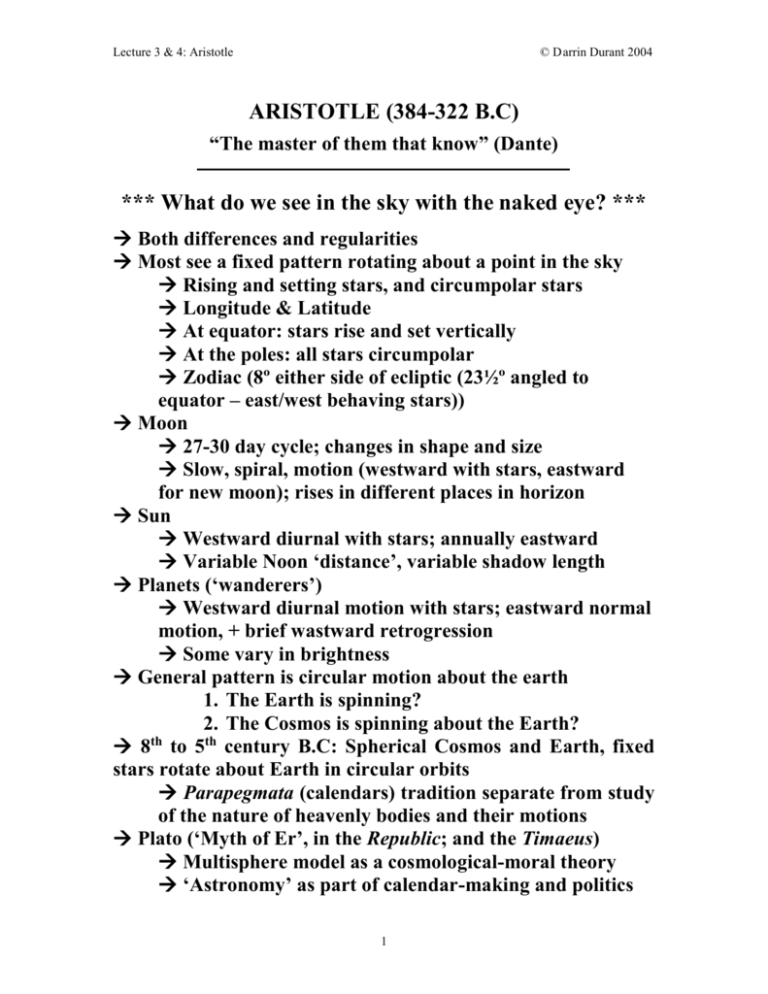
Lecture 3 & 4: Aristotle © D arrin Durant 2004 ARISTOTLE (384-322 B.C) “The master of them that know” (Dante) *** What do we see in the sky with the naked eye? *** Both differences and regularities Most see a fixed pattern rotating about a point in the sky Rising and setting stars, and circumpolar stars Longitude & Latitude At equator: stars rise and set vertically At the poles: all stars circumpolar Zodiac (8º either side of ecliptic (23½º angled to equator – east/west behaving stars)) Moon 27-30 day cycle; changes in shape and size Slow, spiral, motion (westward with stars, eastward for new moon); rises in different places in horizon Sun Westward diurnal with stars; annually eastward Variable Noon ‘distance’, variable shadow length Planets (‘wanderers’) Westward diurnal motion with stars; eastward normal motion, + brief wastward retrogression Some vary in brightness General pattern is circular motion about the earth 1. The Earth is spinning? 2. The Cosmos is spinning about the Earth? th 8 to 5th century B.C: Spherical Cosmos and Earth, fixed stars rotate about Earth in circular orbits Parapegmata (calendars) tradition separate from study of the nature of heavenly bodies and their motions Plato (‘Myth of Er’, in the Republic; and the Timaeus) Multisphere model as a cosmological-moral theory ‘Astronomy’ as part of calendar-making and politics 1 Lecture 3 & 4: Aristotle © D arrin Durant 2004 *** Eudoxus and the Two-Sphere Model *** Joins two traditions: calendars; nature of bodies & motions Eudoxus of Cnidus (390-337 B.C) . . . 341 B.C Basic idea: generate planetary loops out of uniformly rotating spheres (a point on the equator of one of a pair of titled, equally rotating nested spheres = a figure 8; rotate the figure 8 inside a 3rd spehere = a loop) Stars on Sphere of Fixed Stars [SFS] = E to W daily motion Extra nested, homocentric spheres Sun: on a sphere rotating, on its axis, W to E once in a year (1º per day), inside the SFS (+ 1) Moon: W to E inner sphere rotating at 231/3º (+ 1) Planets: 4 spheres per planet Total = 27 spheres Callipus of Cyzicus (370-300 B.C) Sun & Moon = 5 spheres Planets = Jupiter & Saturn (4 each), Mercury, Venus, Mars (5 each) Total = 34 spheres Number of spheres matched complex motions Saturn (29 yrs, retrogress every 378 days), Jupiter (12 yrs, retrogress every 399 days), Mars (22 months, retrogress every 26 months), Venus and Mercury (1 yr, retrogress every 584 and 116 days respectively); sun is faster in winter than summer; moon wobbles along ecliptic *** Aristotle’s Physical System *** Nested concentric spheres… For the Motion of: Number of Spheres: Sphere of Fixed Stars 1 Saturn 4 Jupiter 4 Mars 5 Venus 5 Mercury 5 Sun 5 Moon 5 Total number of spheres + counterturners: 2 Counterturners: 3 3 4 4 4 4 = 56 Lecture 3 & 4: Aristotle © D arrin Durant 2004 *** Aristotle v. Plato *** Aristotle wanted to know why things are the way they are We know via the senses = philosophical knowledge Plato’s Theory of Forms (or Ideas): Eternal, transcendent realities apprehended by thought (Forms or Ideas) v. transient phenomena of experience (sensible particulars) Forms have an independent existence Simile of the Cave (Book VII of the Republic) Difference between reality and appearance “The one over the many” principle Where a plurality is known by single name (‘woman’), there is an ideal (Form of) woman apart from these, by which we recognize each member as a woman “The third (wo)man argument” (Parmenides) Original plurality1 (‘woman’) + ideal = plurality2 (‘women’), ad infinitum Aristotle’s critique of Plato: Individual things are primary substances (ousia = ‘realities’), ‘group categories’ are secondary substances Forms have a dependent existence What are the most readily observable and commonsense properties of the world? Transformed Plato’s ‘dialectic’ (‘collection and division’) Aristotle’s syllogismus: “certain things being stated, something other than what is stated follows of necessity from their being so” E.g.: A. All men are mortal Universal assertion B. Socrates is a man Minor premise C. Therefore Socrates is a mortal Conclusion (particular) An objection: how do you know all men are mortal? Francis Bacon (1620): ‘Circularity objection’ 3 Lecture 3 & 4: Aristotle © D arrin Durant 2004 Aristotle’s attitude to “experience” . . . Perception Memory We perceive… Experience …the same thing = familiarity = Experience countless times… Thus: to have knowledge based on sensory experience is to be familiar with [behaviours & properties] and to assume your audience is familiar with [those behaviours & properties] What happens if something is not ‘familiar’ to you? Explain what is already known or make new discoveries? *** Survival Guide to Aristotle *** Doctrine of Natural Place ‘Natural’ motion/change (internal and teleological – towards a natural place) versus ‘unnatural’ (away from natural place - external, ‘forced’ or ‘violent’) motion/change Terrestrial/Celestial distinction Terrestrial = corruption and change Celestial = perfection and eternity Astrology makes sense All motion requires a mover Doctrine of substantial forms, or ‘real qualities’ Internal causation Locates attributes within bodies Objects (natural or social) activated from inside Teleology 4 causes 4 Lecture 3 & 4: Aristotle © D arrin Durant 2004 *** Geometric Centre to Outermost Sphere *** Celestial Region Lunar Sphere Fire Air Water Earth Table of Opposites Fire Hot Air Cold & Dry = earth Cold & Wet = water Hot & Wet = air Hot & Dry = fire Dry Earth Wet Cold 5 Water Lecture 3 & 4: Aristotle © D arrin Durant 2004 *** The Terrestrial Realm *** No beginning (an eternal cosmos) Prime Matter changed by Pairs of Contraries All Bodies = a mixture of Form & Matter Form is the mover; Matter is moved FOUR CAUSES Material Formal Efficient Final TYPES OF CHANGE 1. Substantial 2. Qualitative 3. Change of Quantity 4. Change of Place 1. Substantial change = generation and corruption (terrestrial) One Form replaced by its contrary Actualization = Contrary in Privation (potentiality) Parmenides’ objection to change: ‘heat has become coldness’ violates law of non-contradiction. Solves Parmenidean problem of change . . . “This hot thing has become cold” Contrary left the substance and replaced by another 4. Change of Place = motion (Doctrine of Natural Place) In the Sublunar Realm Each nested sphere as the natural place of an element Mixed bodies in their natural place Mixed bodies In the Celestial Realm A Plenum, not a Void (non-differentiated places = no natural places to be) ‘Place’ defined by external container There cannot be an infinite cosmos (again, no natural places causes problems) 6 Lecture 3 & 4: Aristotle © D arrin Durant 2004 *** Natural versus Violent Motion *** Motion I (Sublunar) Natural Motion Experience teaches: bodies move to their natural place Absolute heaviness & lightness, not relativistic comparisons Every event has a cause (NOT simply “it moves because it is natural to move”) Essential natures, not Quantitative relations Violent Motion Away from the natural place Medium as both motive power and resistance Vacuum (void) is impossible, because it would imply infinite speed or instantaneous motion No “V F/R” (just ‘time’ and ‘distance’, not ‘velocity’) Motion II (Celestial) Different kinds of motion can be explained by the internal make-up of the Bodies in each realm The 5th element: Ether (perfect, immutable) Terrestrial Elements Natural motion = rectilinear Elements & mixtures in a continual state of flux Contrary qualities = Substantial change Rectilinear motion due to presence of contrary qualities of lightness and heaviness Celestial Ether Natural motion = circular Ether suffers no change (except for ‘place’) No contrary qualities, so no substantial change Without lightness and heaviness, rectilinear motion cannot occur 7 Lecture 3 & 4: Aristotle © D arrin Durant 2004 *** The Celestial Realm *** Is ether matter? If ether is perfect, then was it homogeneous? Homogeneity = non-differentiated In the heavens, bodies already in their natural place Why visible differences? What is the nature of ‘empty space’?: Invisible, ethereal spheres, but also real and physical Cause of Orb motion? External “Intelligences” Internal Principle By virtue of its own nature Unmoved Movers (immaterial) Produce motion by being ‘loved’ Problems? The Prime Mover - Not kinesis, but energeia in the form of nous; no divine providence - Perfection as goal 1. The terrestrial body problem 2. The planetary influence problem *** Aristotle & Internal Causation *** Heavy bodies falling The possibility of other worlds The doctrine of the natural slave The social instinct 8
